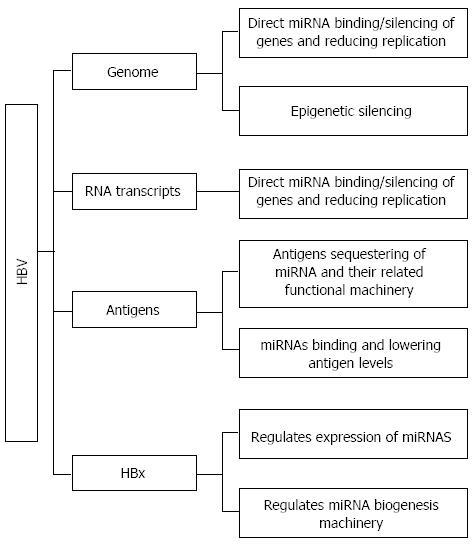Copyright
©2014 Baishideng Publishing Group Inc.
World J Gastroenterol. May 28, 2014; 20(20): 5973-5986
Published online May 28, 2014. doi: 10.3748/wjg.v20.i20.5973
Published online May 28, 2014. doi: 10.3748/wjg.v20.i20.5973
Figure 1 General overview of how miRNAs may associate with hepatitis B virus, apart from acting as biomarkers in chronic hepatitis B-infected or hepatitis B virus-related hepatocellular carcinoma patients.
Hepatitis B virus (HBV) consists of 4 main components that may interact with miRNAs: The genome, RNA transcripts, the various antigens and the pleiotropic hepatitis B virus X (HBx) protein. MiRNAs may bind to the genome, resulting in the silencing of tumour-suppressor genes, or this could be achieved epigenetically through miRNAs’ modulation of histone deacetylase etc. The binding of miRNAs to HBV DNA or RNA transcripts may also regulate HBV replication, a mechanism that may lead to latency and chronic hepatitis B infection. Important protein products like the various antigens and HBx could also regulate miRNA activity. The antigens are found to localize with miRNAs and Argonaute2, which may result in their sequestering and loss of function. MiRNAs, conversely, are found to target and reduce the expression levels of circulating antigens. HBx protein affects miRNAs at both an individual level, by regulating specific miRNAs’ expression, and also at a general miRNA level, by decreasing the level of Drosha, an enzyme involved in the biogenesis of miRNAs. As miRNAs are able to regulate mRNA and subsequently protein levels, the effect of HBV on the miRNA profile is considerable, implying its potentially substantial modulation of important cellular activities.
- Citation: Tan YLJ, Chen WN. MicroRNAs as therapeutic strategy for hepatitis B virus-associated hepatocellular carcinoma: Current status and future prospects. World J Gastroenterol 2014; 20(20): 5973-5986
- URL: https://www.wjgnet.com/1007-9327/full/v20/i20/5973.htm
- DOI: https://dx.doi.org/10.3748/wjg.v20.i20.5973









